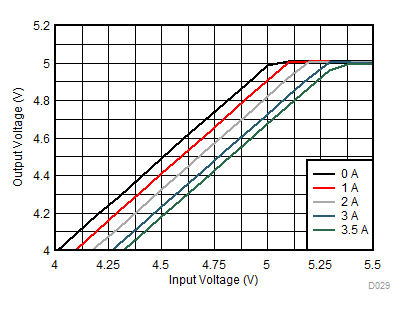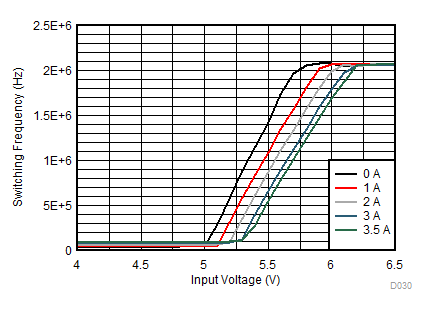ZHCSO42B December 2015 – July 2021 LM53625-Q1 , LM53635-Q1
PRODUCTION DATA
- 1 特性
- 2 应用
- 3 说明
- 4 Revision History
- 5 Device Comparison
- 6 Pin Configuration and Functions
- 7 Specifications
- 8 Detailed Description
-
9 Application and Implementation
- 9.1 Application Information
- 9.2
Typical Applications
- 9.2.1 General Application
- 9.2.2 Fixed 5-V Output for USB-Type Applications
- 9.2.3 Fixed 3.3-V Output
- 9.2.4 Adjustable Output
- 9.3 What to Do and What Not to Do
- 10Power Supply Recommendations
- 11Layout
- 12Device and Documentation Support
- 13Mechanical, Packaging, and Orderable Information
封装选项
请参考 PDF 数据表获取器件具体的封装图。
机械数据 (封装 | 引脚)
- RNL|22
散热焊盘机械数据 (封装 | 引脚)
- RNL|22
订购信息
8.4.3 Dropout
One of the parameters that influences the dropout performance of a buck regulator is the minimum off time. As the input voltage is reduced, to near the output voltage, the off time of the high-side switch starts to approach the minimum value (see Section 7.5). Beyond this point the switching may become erratic and/or the output voltage falls out of regulation. To avoid this problem, the LM53625/35-Q1 automatically reduces the switching frequency to increase the effective duty cycle. This results in two specifications regarding dropout voltage, as shown in Section 7.6. One specification indicates when the switching frequency drops to 1.85 MHz; avoiding the A.M. radio band. The other specification indicates when the output voltage has fallen to 3% of nominal. See the Section 9.2.2.3 for typical dropout values. The overall dropout characteristic for the 5-V option can be seen in Figure 8-11 and Figure 8-12. The SYNC input is ignored during frequency foldback in dropout. Additional dropout information is discussed in for 5-V output (Section 9.2.2.3 and for 3.3 V output (Section 9.2.3.3).
 Figure 8-11 Overall Dropout Characteristics (VOUT = 5 V)
Figure 8-11 Overall Dropout Characteristics (VOUT = 5 V) Figure 8-12 Frequency Dropout Characteristics (VOUT = 5 V)
Figure 8-12 Frequency Dropout Characteristics (VOUT = 5 V)